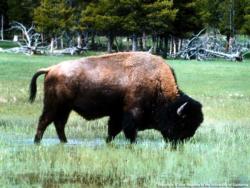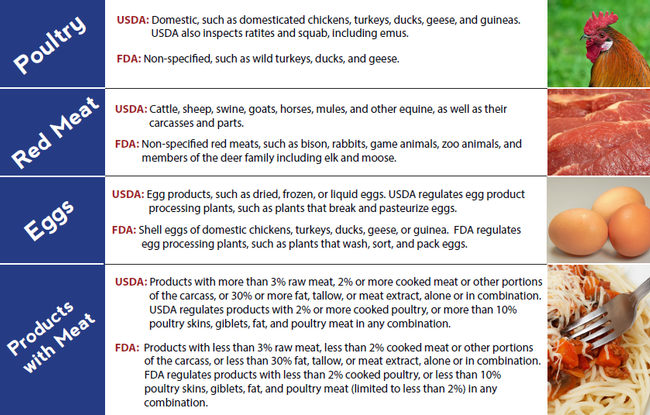Non-Amenable Species
As a rule, wild killed game is not allowed to be sold.
Have a question?
Ask the Ag Ombudsman
Non-amenable species meat may be sold if slaughtered and processed at a CDFA licensed or USDA inspected plant. Exotic species must be slaughtered in a facility that conforms to Good Manufacturing Practices (Code of Federal Regulations, Title 21, Part 110).

- USDA inspected facility
- CDFA licensed/CDPH registered food processing facility.
USDA Small Plant News Vol5 No4: Harvesting Wild Game
Chefs Gone Wild: Hunting, Game and the Restaurant Industry, Star Chefs, Oct 2010
Exotic animals can be slaughtered under voluntary USDA inspection. Meaning you would pay for the inspection services and you would have to find a firm that would do it for you. Because each species must be processed separately, this is quite costly for the processor, therefore economies of scale are needed.
The USDA regulations for Exotic (Non-Amenable) Species are as follows:
Inspection Program Personnel (IPP) are to conduct ante-mortem and post-mortem inspection on exotic animals (bison or buffalo, deer, elk, antelope, reindeer, or water buffalo) under 9 CFR Part 352. Part 352 refers to 9 CFR Part 309 for ante-mortem inspection of exotic animals that is not to be done in the field and to Part 310 for post-mortem inspection. Ante-mortem inspection is to be conducted according to FSIS Directive 6100.1, Ante-mortem Livestock Inspection, Section VIII, except the non-ambulatory disabled section which applies to cattle only. Post-mortem inspection is to be conducted according to FSIS Directive 6100.2, Post-mortem Livestock Inspection:
- for mature bison, buffalo, elk, and large deer, inspectors are to use post-mortem inspection procedures in Chapter 2, Section I, Cattle
- for young bison, buffalo, and elk, inspectors are to use post-mortem inspection procedures in Chapter 2, Section II, Calves
- for antelope and small deer, inspectors are to use post-mortem inspection procedures in Chapter 2 Section III, Lamb or Section IV Sheep.

CA Dept of Public Health Regulation for Game
In California, the facility that slaughters and processes game meat will need to be licensed by CDFA MPES and a registered food processing facility.
Definitions
Approved Source 113735
Approved source" means a food source allowed under Article 3 (commencing with Section 114021) of Chapter 4, or a producer, manufacturer, distributor, or food facility that is acceptable to the enforcement agency based on a determination of conformity with applicable laws, or, in the absence of applicable laws, with current public health principles and practices, and generally recognized industry standards that protect public health.
Game Animal 113795:
(a) "Game animal" means an animal, the products of which are food, that is not classified as cattle, sheep, swine, goat, horse, mule, or other equine in 9 C.F.R. 301, as poultry in 9 C.F.R. 381, or as fish as defined under Subpart 1 -201.10(B)(31) of the Food and Drug Administration 2001 Food Code.
(b) "Game animal" includes mammals such as reindeer, elk, deer, antelope, water buffalo, bison, rabbit, squirrel, opossum, raccoon, nutria, or muskrat, and nonaquatic reptiles such as land snakes.
(c) "Game animal" does not include ratites such as ostrich, emu, and rhea.
Food from Approved Sources 114031:
(a) Game animals shall be received from an approved source.
(b) A game animal shall not be received for sale or service if it is a species of wildlife that is listed in 50 C.F.R. 17 Endangered and Threatened Wildlife and Plants or is listed as an endangered or threatened animal by the Department of Fish and Game.
(c) The enforcement agency may approve the use of legally obtained donated fish and game by nonprofit organizations authorized to serve meals to indigent persons.
Food & Drug Administration and Game
FDA is responsible for protecting consumers against impure, unsafe, and fraudulently labeled food covered under the Federal Food, Drug, and Cosmetic Act (FD&C Act). This includes products not covered by the USDA’s Poultry Products Inspection Act (PPIA) and Federal Meat Inspection Act (FMIA). Meat from game animals and birds are not covered by those acts and are regulated by FDA under the FD&C Act. Game meat produced domestically, as well as shipped from other countries, must meet the same safety standards applied to all foods domestically produced and offered for entry into U.S. interstate commerce. Additionally, if offered for sale as a consumer commodity, they must also meet the requirements of the Fair Packaging and Labeling Act (FPLA). from Game Meat: A Complex Food Safety and Animal Health Issue, Food Safety Magazine Dec 2004/Jan 2005.
From FDA Food Code 2017:
Definitions:
(1) "Game animal" means an animal, the products of which are FOOD, that is not classified as livestock, sheep, swine, goat, horse, mule, or other equine in 9 CFR 301.2 Definitions, or as Poultry, or FISH.
(2) "Game animal" includes mammals such as reindeer, elk, deer, antelope, water buffalo, bison, rabbit, squirrel, opossum, raccoon, nutria, or muskrat, and nonaquatic reptiles such as land snakes.
(3) "Game animal" does not include RATITES.
3-201.17 Game Animals:
(A) If GAME ANIMALS are received for sale or service they shall be:
(1) Commercially raised for FOOD P(P=FDA's Employee Health and Personal Hygiene Handbook) and:
(a) Raised, slaughtered, and processed under a voluntary inspection program that is conducted by the agency that has animal health jurisdiction, P or
(b) Under a routine inspection program conducted by a regulatory agency other than the agency that has animal health jurisdiction, P and
(c) Raised, slaughtered, and processed according to:
(i) LAWS governing MEAT and POULTRY as determined by the agency that has animal health jurisdiction and the agency that conducts the inspection program, P and
(ii) Requirements which are developed by the agency that has animal health jurisdiction and the agency that conducts the inspection program with consideration of factors such as the need for antemortem and postmortem examination by an APPROVED veterinarian or veterinarian’s designee; P
(2) Under a voluntary inspection program administered by the USDA for game animals such as exotic animals (reindeer, elk, deer, antelope, water buffalo, or bison) that are "inspected and APPROVED" in accordance with 9 CFR 352 Exotic Animals; Voluntary Inspection or rabbits that are "inspected and certified" in accordance with 9 CFR 354 Voluntary Inspection of Rabbits and Edible Products Thereof; P
(3) As allowed by LAW, for wild GAME ANIMALS that are live-caught:
(a) Under a routine inspection program conducted by a regulatory agency such as the agency that has animal health jurisdiction, P and
(b) Slaughtered and processed according to:
(i) LAWS governing MEAT and POULTRY as determined by the agency that has animal health jurisdiction and the agency that conducts the inspection program, P and
(ii) Requirements which are developed by the agency that has animal health jurisdiction and the agency that conducts the inspection program with consideration of factors such as the need for antemortem and postmortem examination by an APPROVED veterinarian or veterinarian’s designee; P or
(4) As allowed by LAW, for field-dressed wild GAME ANIMALS under a routine inspection program that ensures the animals:
(a) Receive a postmortem examination by an APPROVED veterinarian or veterinarian's designee, P or
(b) Are field-dressed and transported according to requirements specified by the agency that has animal health jurisdiction and the agency that conducts the inspection program, P and
(c) Are processed according to LAWS governing MEAT and POULTRY as determined by the agency that has animal health jurisdiction and the agency that conducts the inspection program. P
(B) A GAME ANIMAL may not be received for sale or service if it is a species of wildlife that is listed in 50 CFR 17 Endangered and threatened wildlife and plants.